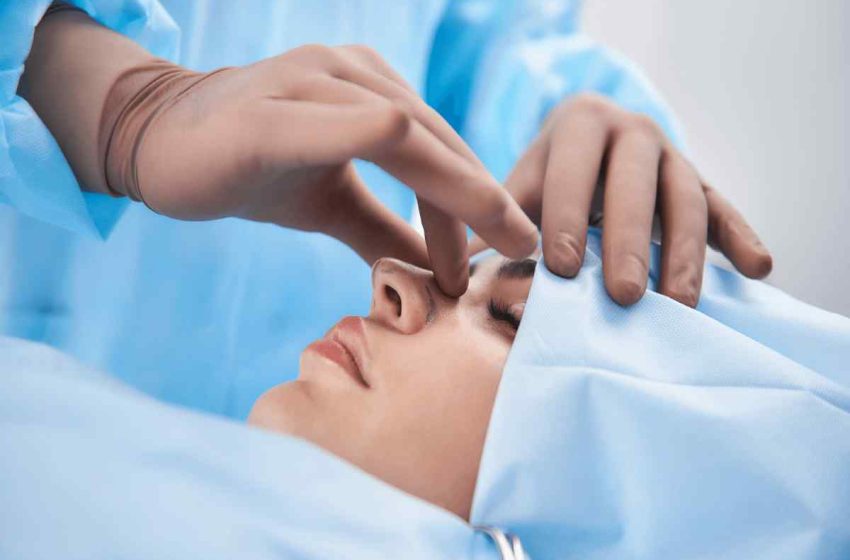
Open Vs. Closed Rhinoplasty: Which Should You Choose?
Open Vs. Closed Rhinoplasty
The nose is one of our most prominent features.
Women and men with a very large nose, a bump, crookedness, or another feature they don’t like may consider rhinoplasty. Other patients have a physical condition, such as a deviated septum, and turn to plastic surgery to correct it.
All in all, a “nose job” is the most common facial plastic surgery procedure in the U.S., with 220,000 performed each year.
Nose surgery can change how you look and boost your confidence by making you more comfortable in your own skin. If you’re investigating what goes into having a nose job, you may have heard of two common procedures: open and closed rhinoplasty.
Both can yield excellent results, but there are key differences. Let’s take a deeper dive into the two common rhinoplasty options, what your recovery may be like with each, and which factors make one or the other a surgeon’s and patient’s top choice.
Table of Contents
What Is Closed Rhinoplasty?
Closed rhinoplasty is a method of reaching structures inside the nose that need to be changed (like bone and cartilage) by making incisions inside the nostrils.
What Is Open Rhinoplasty?
With the open rhinoplasty technique, the incision is not made inside the nasal passages. Instead, the surgeon cuts across the columella (the tissue between the nostrils) to get to the structures inside the nose that need to be changed.
Which Should You Choose?
You can give your input on which type of rhinoplasty you would like to have, but your plastic surgeon will know best which can accomplish your goals, so it is important to sit down and have a talk about exactly what your own procedure will entail.
In addition, some plastic surgeons excel in one technique over the other; they have their “signature” nose surgery technique.
The primary reasons we will list below in Pros Vs. Cons factor into whether your doctor will steer you toward one technique over the other.
Pros Vs. Cons of Each Technique
Here are the primary advantages and disadvantages that will figure into your and your surgeon’s decision on which to choose:
Open Rhinoplasty
Pros:
- Visibility is better for the surgeon, so you may get a much more precise result
- Stitching opened areas together is straightforward
Cons:
- There are more incisions
- You may have a tiny scar (though with an experienced surgeon, this will be minimized)
Closed Rhinoplasty
Pros:
- Stitches are usually dissolvable, so you won’t need any removed
- You should not have visible scars
Cons:
- Your result may not be as precise as it would be with open rhinoplasty
- The surgery is much more difficult and involved; choose your surgeon carefully
Recovery Timeline for Closed and Open Rhinoplasty
Overall, the recovery for both procedures will follow the same series of steps.
Keep in mind that while it can deliver more attractive and precise results, open rhinoplasty may take slightly longer than the closed method due to healing of the incisions and removal of the sutures (stitches).
Week 1
Your nose may be covered with an external splint during this time, and of course you will be bandaged up. This means you will not be able to breathe well through your nose. Remember that this stage is temporary.
You will be encouraged to engage in very light activity, such as walking around your house, to prevent post-surgery blood clots.
Your doctor should have sent you home with a medication prescription to address the discomfort you will be feeling. The area will be very bruised and may be swollen.
Get help during this time if possible, as your activities will be limited. For instance, you can not lift heavy objects or drive yet.
Week 2
If you have removable stitches, your plastic surgeon will probably remove them during this time. Your splint may also be removed.
You can breathe much better now, and your discomfort should begin to fade by the end of this week. Take medications exactly as your doctor directs.
You will still have quite a bit of bruising and some swelling.
Week 3
You may be approved to return to work sometime this week. Your surgeon will tell you whether you’re ready to drive and go to work.
Swelling should be down significantly, and your bruises are changing to a “fading” color.
Be very careful of sun exposure, particularly if you had external stitches or an external incision. Scars heal much better when they are protected from UVA and UVB rays from the sun.
Weeks 4 to 8
You’re beginning to look and feel much more like yourself now. You should not require medications at this point. If you are still experiencing discomfort, let your plastic surgeon know.
You are cleared to go back to work and to drive, and if your recovery is going well, you can also resume activities such as a daily workout routine toward the end of this period.
Months 3 to 6
You are approved for activities such as contact sports. Your bruising will be gone by now, but a very small amount of residual swelling can last into this period.
By about six months, you should have your final, gorgeous new result. Enjoy!


